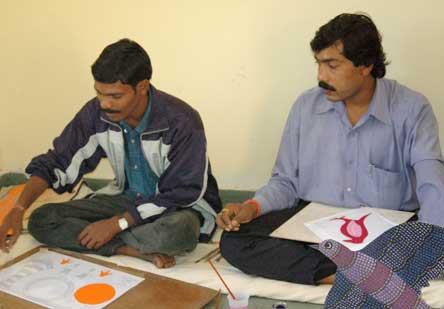Janapada Sampada
Animation Workshop with the Tribal Artists July 8-23, 2008
Animation is becoming increasingly important as a medium of communication. In all possible area of human interaction and communication, animation is used a powerful medium of expression. It has become imperative for survival upon the earth to expand the perceptions of people everywhere by making deep and wide ranging content arrays for creatively processing sets of encounters as designs for working to manage different kinds of relationships. Audio visual communication scans sets of information units as interdependent circuits of independently selected growth patterns. Themes of concern are to be systematically set as topics and the analyzed inferences are animated to portray not only modes and models of physical and material growth but also the placed and conditioned parameters of collective coexistence. Episodes about reality formation are illustrated in pragmatic frameworks to enhance and enrich the flowing orders that surround our applied humanism.

The Indira Gandhi National Centre for the Arts (IGNCA) has been working with the tribal communities of India to explore all possible dimensions of their creative activity. The IGNCA has organized workshops to understand the craftsmanship of folk and tribal artists of India. In this direction creative activity of Gond, Santhal, Oraon, Nagas (all Naga groups), Kom, Mishmis (Idu, Digaru and Miju), Rathva Bhills and Bhills, Mithila Painters, Kantha workers, Phukari embroidery artists, Jadu Patua artists, Warli etc. are documented analyzed and popularized. Attempts are made to make these art activities as living and continuous activities.
Tribal and folk artists and related people should get equal opportunity to compete themselves in the competitive world of market and all possible dimensions of concerns. Animation is one such area. Keeping this mind, the Indira Gandhi National Centre for the Arts in collaboration with Adivasi Art Trust has been organizing a 15-Day Animation Workshop with the Tribal and Folk artists from North East, Jhrakhand, West Bengal, Bihar, Madhya Pradesh and Chhatisgarh. The workshop began on 8th July 2008 and it will continue till July 23rd 2008 at the New Building of IGNCA.
The professionals from the National Institute of Design, Ahmedabad, and other free-lance experts have been closely associated in this workshop. Several professionals, scholars and storytellers, have been invited as observers and the workshop is getting constant encouraging observations from all of them. Sri Shekhar Mukherjee, Coordinator, Department of Animation and Design of National Institute of Design came personally on July 16, 2008 to evaluate the progress of the workshop and also to deliver a special lecture. After interacting with the artists of the workshop, Sri Mukherjee expressed his utmost pleasure and promised to work with the IGNCA and the Adivasi Art Trust in collaborative projects on animation in future.
Dr. K. K. Chakravarty, Member Secretary of the Indira Gandhi National Centre for the Arts interacted with the tribal and folk artists and the professional animators and promised to do such activities for the betterment of the art forms. Dr. Chakravarty, in his observation, said, “The purpose of the workshop is to use the huge IGNCA’s ethnographic collection for the animation films and to go to the tribal and folk community of India so that they can understand how the Centre has been utilizing the objects and ideas that it has taken or acquired from them.” He also stressed the need to have a common platform of other departments of the Government and the service sectors as well as the NGOs, artists groups and social animators to use the local resources of the people as the tools for the development. “Beauty and utility are seen together”, said Dr. Chakravarty, “in the folk and tribal creativity which can certainly be used as cultural indicators of development.” He concluded.
The participants – Dimasa, Nagas, Kukis, Meities, Mithila Artists, Gonds, Santhals, and Indentured Tea Garden Tribes – developed three scripts from their existing folklore and accordingly started working on making 3 small animation films. Some 15 IGNCA officials have also been participating in this workshop.

The resource persons said that though it is said that the first animation film was made in 1894 but the evidences from the cave and rock paintings from all over the world suggest that the tribal people were very well aware of this technique in more than 5000 years ago. In one rock painting, for example, one bison has been shown having eight legs. Again, all the signs, sketches and motifs of rock art of anywhere – Bhimbetka of India or Alitmara or Spain or Germany or anywhere of the world – are very moving and dynamic. They are not static. The dynamism is the essence of animation. Language is also not a big barrier for the animation. There are well known animation films in which there is no dialogue at all. The best and the initiator of animation technology got their ultimate clues only after visiting India, other parts of Asia and the Third World countries. The verities of cultural patterns, people’s exploitations and many other factors influenced them to create animation of different order. And, accordingly, a new beginning in the field of animation initiated.
Ms. Tara Douglas, main Animation Resource Person of this workshop has been doing an extraordinary job with the animation experts mainly from the National Institute if Design, Ahmedabad. The laurels and appreciation that the IGNCA is getting from the participants and the visitors are the true indicators of the success of the workshop. The script, the participants, the Story Board, the sketches, the songs, the narratives, the paintings, the art objects, the sketches and the animation, everything is of this workshop gives a unique experience to the visitors.




